We're celebrating our new website -
and you get. . .
and you get. . .
A special 10% Off!
Simply enter LAUNCH10 at checkout to redeem your discount. Don’t miss out on this limited time offer!
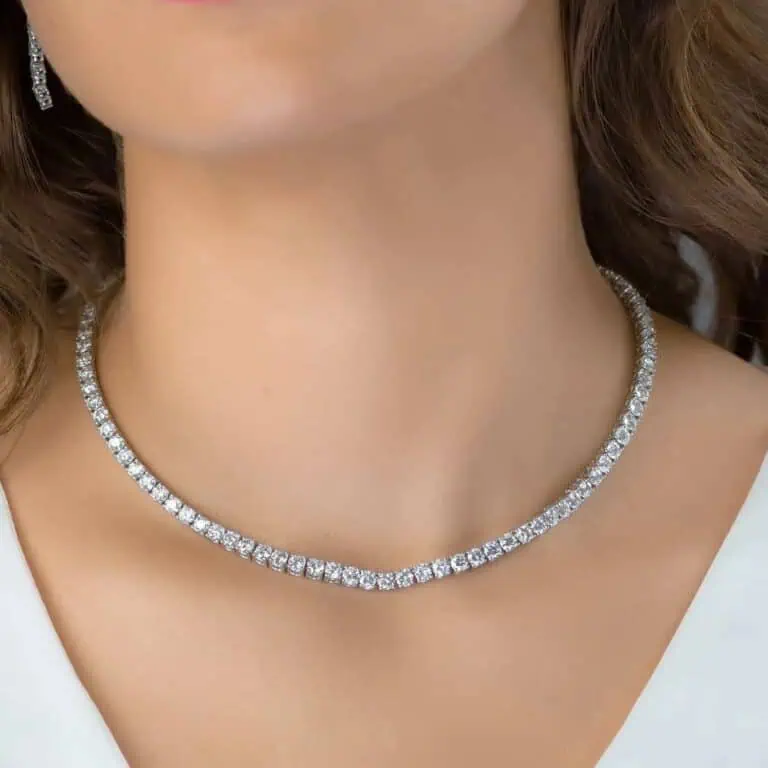
A diamond necklace is a symbol of beauty and grace, reflecting light in a way that captivates the eye. The sparkle of these precious gems can be absolutely enchanting, instantly elevating any ensemble.
To preserve this breathtaking beauty, regular cleaning is a must. Over time, dust and dirt can accumulate on the surface of your diamond necklace, causing it to lose its luster. Keeping your necklace in pristine condition not only enhances its visual appeal but also helps it last longer.
Discover effective methods for maintaining the brilliance of your diamond necklace, ensuring that it remains as dazzling as the day you first put it on. Whether you’ve created a customized piece using our jewelry design service or simply require expert guidance, our team of specialists is always ready to assist you with any inquiries or concerns you may have.
Regularly cleaning your diamond necklace is crucial to keeping it looking stunning and radiant. Here are some key reasons why cleaning your diamond necklace is important:
If you’re interested in exploring more exquisite jewelry pieces like diamond engagement rings, we invite you to visit our Engagement Rings Collection on Ariel Jewelry’s website.
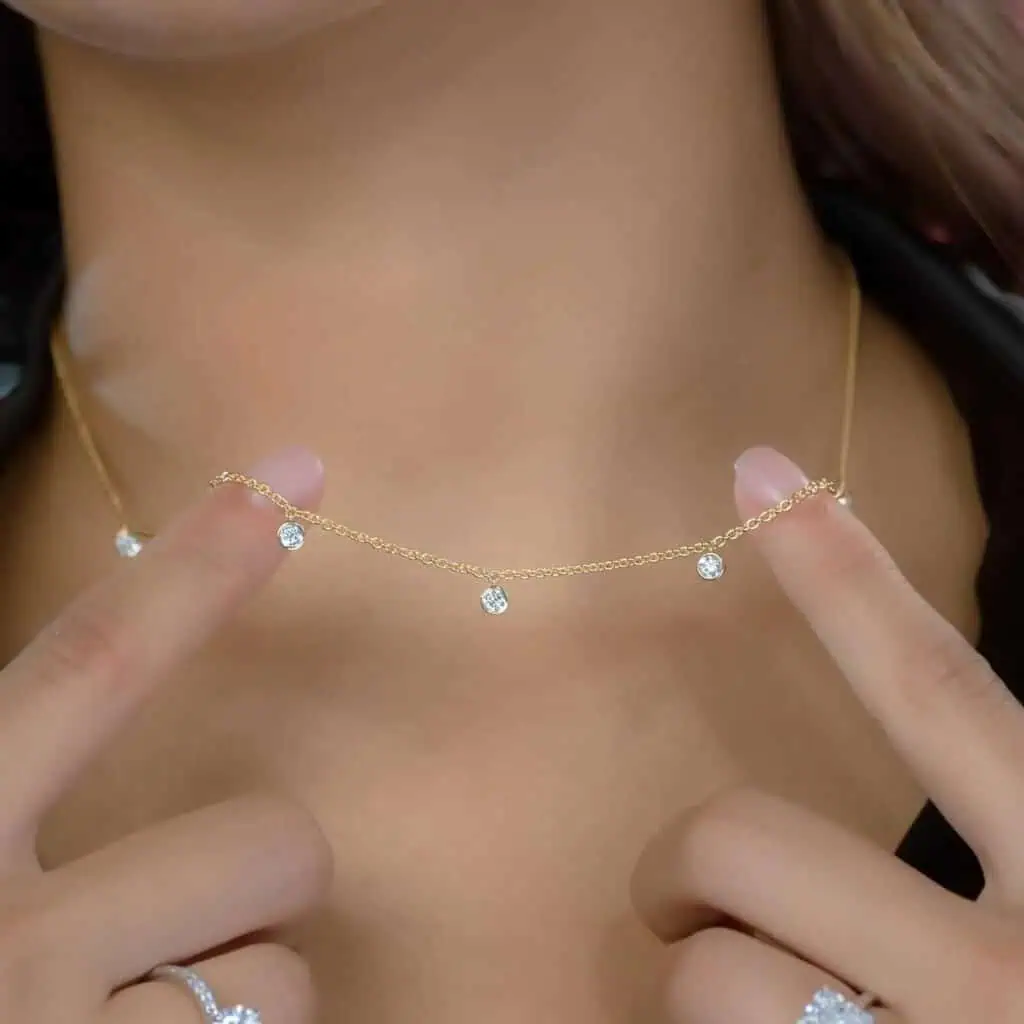
When it comes to cleaning tools for a diamond necklace, selecting the right materials ensures both effectiveness and safety. Here are some essential items:
A soft-bristled toothbrush is gentle enough to avoid scratching the delicate surfaces of diamonds while effectively removing dirt and grime. Its small size allows for precise cleaning, especially in hard-to-reach areas.
A soft cloth, such as microfiber or a lint-free cloth, helps in wiping away residues without causing abrasion. It’s perfect for drying and polishing your necklace to restore its sparkle.
A simple yet efficient homemade solution includes warm water mixed with a few drops of mild dish soap. This combination dissolves oils and loosens dirt accumulated on the necklace.
The mild nature of dish soap ensures that it won’t damage the metal or stones. Using warm water aids in breaking down residues more effectively compared to cold water.
Solutions for cleaning jewelry should be chosen carefully to maintain the integrity of your precious pieces. By sticking to these gentle tools and solutions, you can keep your diamond necklace looking radiant without risking any damage.
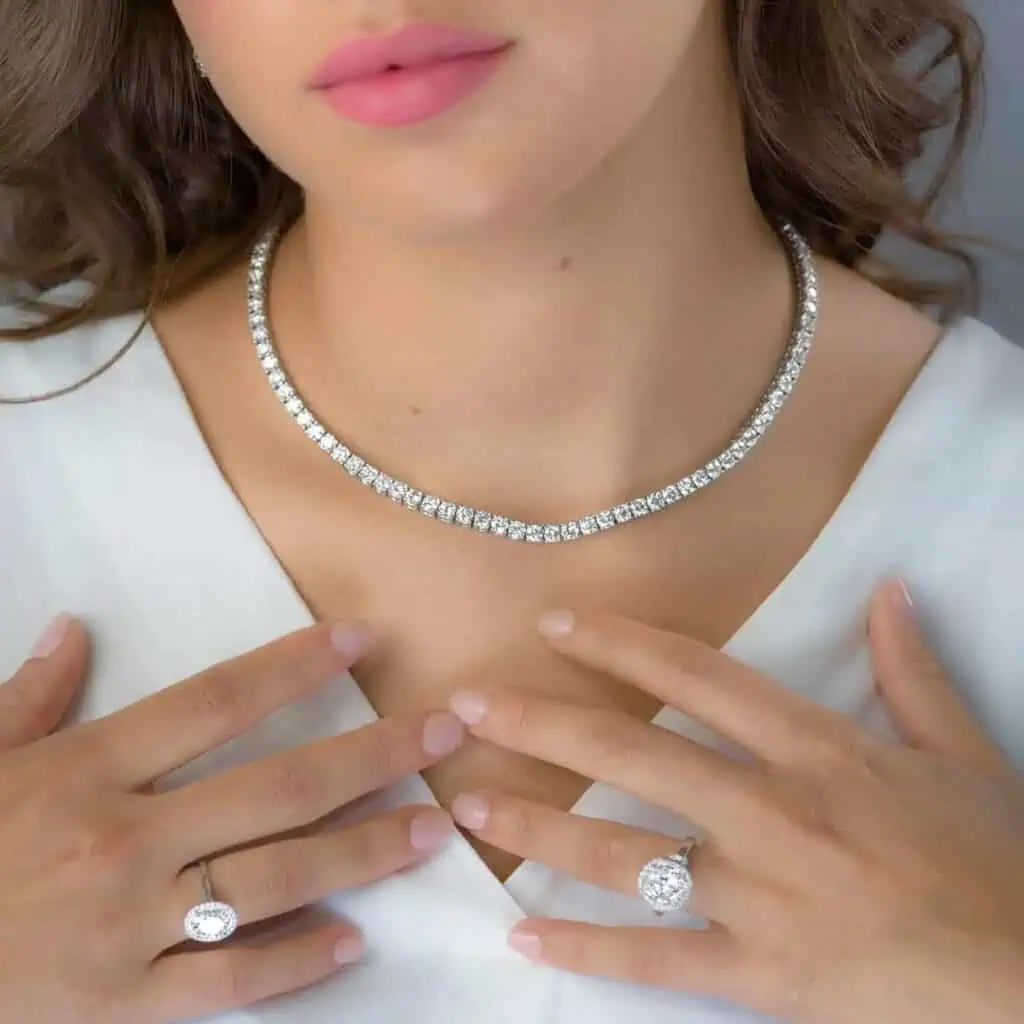
When it comes to maintaining the brilliance of your diamond necklace, a detailed cleaning routine can make a significant difference. Here is a step-by-step guide to clean a diamond necklace effectively:
This thorough cleaning routine will help ensure your diamond necklace remains radiant and dazzling. Always handle your jewelry with care during cleaning to prevent damage and maintain its elegance for years to come.
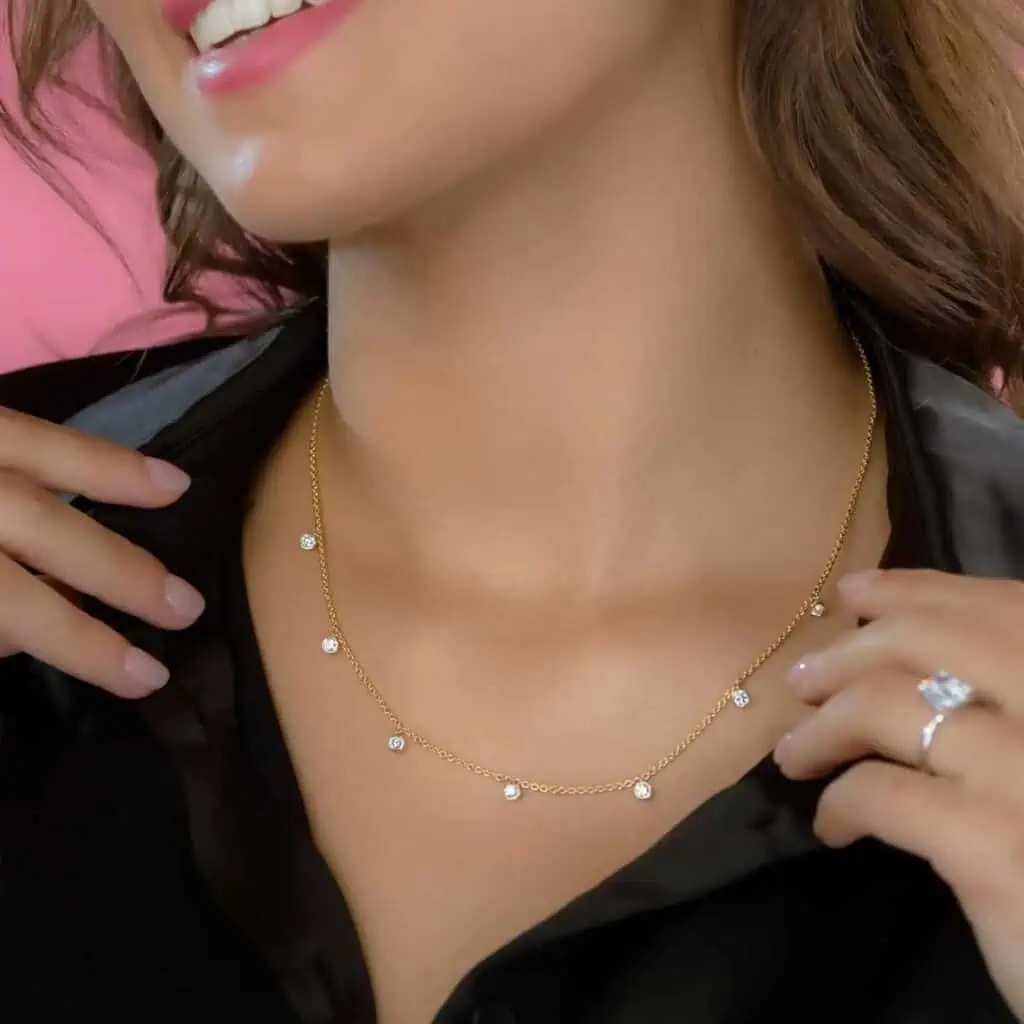
To ensure the longevity and brilliance of your diamond necklace, consider these additional tips for diamond necklace maintenance:
These practices help in preserving both the aesthetic appeal and structural durability of your diamond necklace. Regular attention ensures it remains a stunning accessory for years to come.
Cleaning non-diamond gemstones requires specific methods tailored for each type of stone. Unlike diamonds, many gemstones are softer and can be damaged by harsh cleaning techniques. Here’s how to care for different gemstones:
These stones are often treated with oils, making them susceptible to damage from soapy water. Clean them with a soft cloth and lukewarm water, avoiding any detergents.
Known for their delicate composition, opals should never be soaked in water or exposed to extreme temperatures. Use a damp cloth for cleaning.
Being organic gems, pearls require gentle care. Wipe them down with a soft, damp cloth after wearing and avoid using any abrasive materials.
These durable stones can handle more rigorous cleaning. Use warm water mixed with mild dish soap and a soft toothbrush for effective maintenance.
For multi-gemstone jewelry, consider the most delicate stone when choosing your cleaning method to ensure all components remain undamaged. Always research or consult professionals regarding the best practices for the specific gemstones in your collection.
Using these tailored approaches helps preserve the natural beauty and integrity of each non-diamond gemstone, adding longevity to your cherished pieces.
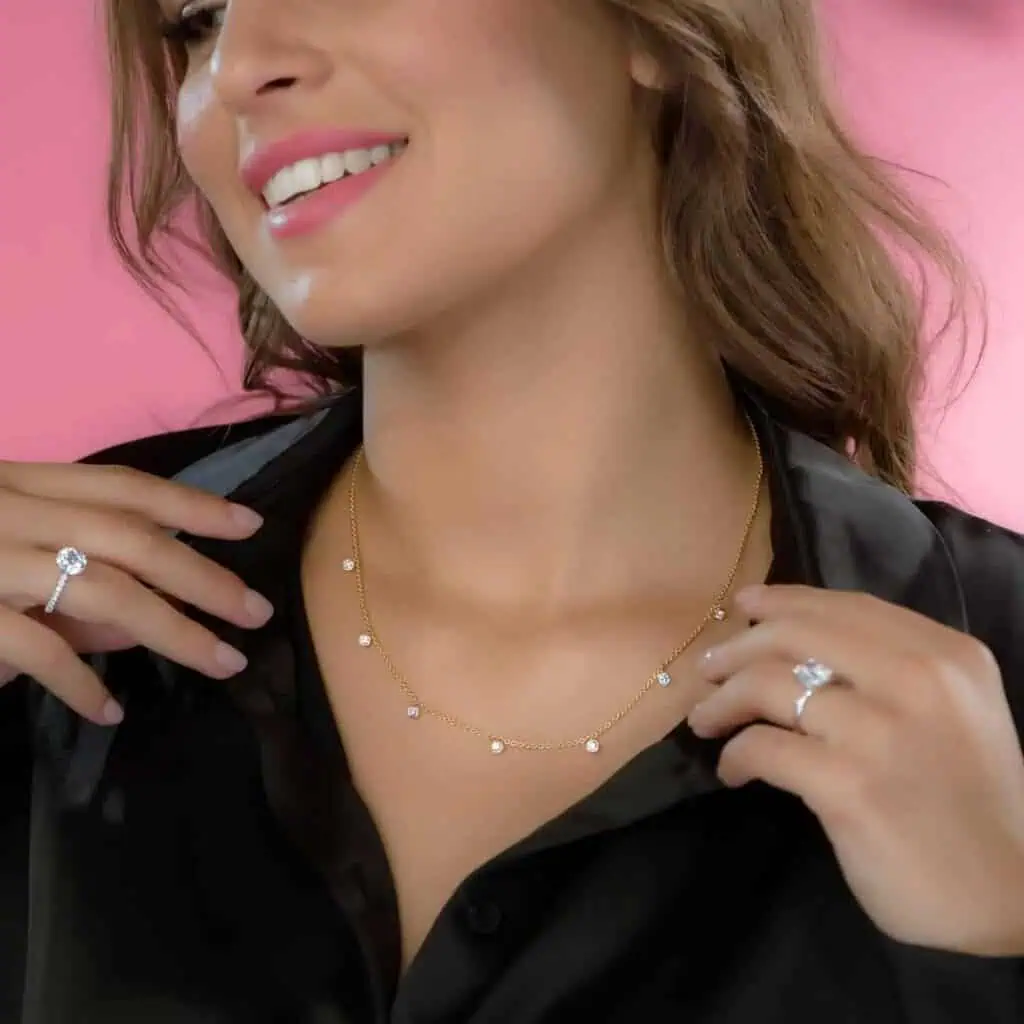
Ensuring the longevity and pristine condition of your diamond necklace involves proper storage. Here are some effective strategies:
Proper storage not only preserves the beauty of your diamond necklace but also ensures its longevity and value. By taking these simple steps, you can keep your precious piece sparkling and safe for years to come.
Maintaining your diamond necklace’s beauty and longevity is simple with regular cleaning and proper care. By following the provided guidelines, you ensure that your precious piece remains dazzling and free from damage.
A clean and sparkling diamond necklace catches everyone’s attention and enhances your overall look. It also holds sentimental value, becoming a cherished heirloom that can be passed down through generations.
“A well-maintained diamond necklace is not just an accessory; it is a timeless piece of elegance that tells a story.”
For more tips on jewelry care, visit Ariel Jewellery.
It’s recommended to clean your diamond necklace every few weeks if you wear it regularly. This helps prevent dirt and oil buildup, ensuring it remains dazzling.
No, you should use a mild dish soap. Harsh chemicals or abrasive cleaners can damage the diamond or the metal setting of your necklace.
Yes, using a soft-bristled toothbrush is safe and effective for cleaning the intricate details of your diamond necklace without scratching the surface.
Avoid using bleach, abrasive cleaners, and ultrasonic cleaners if your necklace has delicate settings. Also, avoid extreme temperatures, as they can damage the metal or stones.
To keep your diamond necklace clean for longer, avoid wearing it while applying lotions, perfumes, or engaging in activities that cause sweating. Store it properly in a soft cloth pouch or a separate jewelry box.
Yes, you can use a baking soda paste for a deeper clean. Mix baking soda with water to create a paste, apply it gently with a soft toothbrush, rinse thoroughly, and dry with a soft cloth.
Yes, professional cleaning is recommended every 6 months to a year. Jewelers have specialized tools to clean hard-to-reach areas and can inspect the necklace for any needed repairs.
It’s best to avoid wearing your diamond necklace while swimming. Chlorine and saltwater can damage the metal setting and dull the diamonds.
Store your diamond necklace in a soft cloth pouch or a separate compartment in your jewelry box to prevent scratches and tangling with other jewelry pieces.
If your necklace gets tangled, gently untangle it using your fingers or a soft tool. Avoid pulling forcefully to prevent damage to the chain or setting.
Our newsletter is the perfect mixture between professional good-to-knows and occasional deal & coupons.
Want just one or the other? Join us. You’ll get exactly what you want.
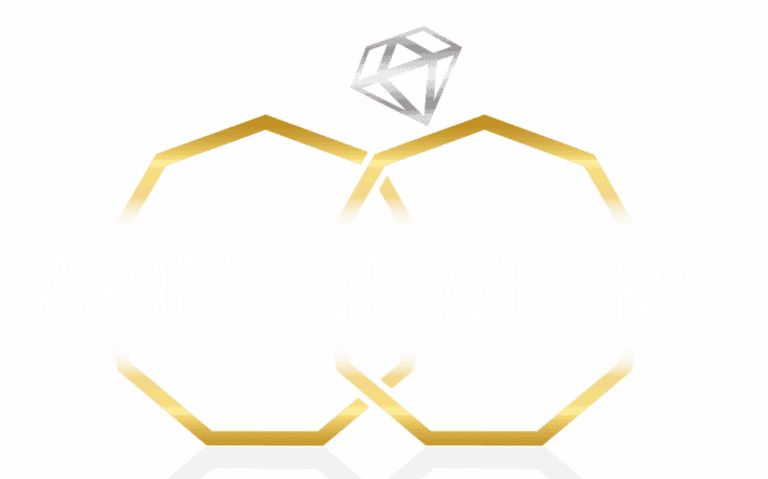
Boutique, family owned, handcrafted Jewelry Design team.
Between quality materials, impeccable design and personal customer service —
We choose all.
We are here for you call US:
+1 (917)-477-8663

If you would like to measure your ring size immediately the quickest ways and with an accurate fit – you can do it with our Ring Size Chart here.
The way to quickly get your measurements is either going to the nearest jewelry shop and ask them to measure you, or to buy a Ring Sizer Measuring Gauge with a 2-day delivery to the US!
Then you can match your measurement to the size chart below to get your exact ring size.
A few factors we recommend to consider for the perfect measure:
Still not sure what your size is or what to choose for your love one? We’re here to help!
| MM | Inches | MM | Inches | UK/AU | US & Canada & Mexico | France | Germany & Russia & Ukraine & Asia | India & China & Japan & South America | Italy & Spain & Netherlands & Switzerland |
| 14.05 | 0.553 | 44.14 | 1.74 | F | 3 | 44 | 14 | 4 | 4 |
| 14.25 | 0.561 | 44.77 | 1.76 | F 1/2 | 3.25 | 44.625 | 14.25 | 4.5 | 4.625 |
| 14.45 | 0.569 | 45.4 | 1.79 | G | 3.5 | 45.25 | 14.5 | 5 | 5.25 |
| 14.65 | 0.577 | 46.02 | 1.81 | H | 3.75 | 45.875 | 14.75 | 6 | 5.875 |
| 14.86 | 0.585 | 46.68 | 1.84 | H 1/2 | 4 | 46.5 | 15 | 7 | 6.5 |
| 15.04 | 0.592 | 47.25 | 1.86 | I | 4.25 | 47.125 | 15.25 | 7.5 | 7.125 |
| 15.27 | 0.601 | 47.97 | 1.89 | I 1/2 | 4.5 | 47.75 | 15.5 | 8 | 7.75 |
| 15.53 | 0.611 | 48.79 | 1.92 | J 1/4 | 4.75 | 48.375 | — | 8.5 | 8.375 |
| 15.7 | 0.618 | 49.32 | 1.94 | J 1/2 | 5 | 49 | 15.75 | 9 | 9 |
| 15.9 | 0.626 | 49.95 | 1.97 | K 1/4 | 5.25 | 49.625 | 16 | 9.5 | 9.625 |
| 16.1 | 0.634 | 50.58 | 1.99 | L | 5.5 | 50.25 | 16.25 | 10 | 10.25 |
| 16.3 | 0.642 | 51.21 | 2.02 | L 1/4 | 5.75 | 50.875 | — | 11 | 10.875 |
| 16.51 | 0.65 | 51.87 | 2.04 | M | 6 | 51.5 | 16.5 | 12 | 11.5 |
| 16.71 | 0.658 | 52.5 | 2.07 | M 1/2 | 6.25 | 52.125 | 16.75 | 12.5 | 12.125 |
| 16.92 | 0.666 | 53.16 | 2.09 | N | 6.5 | 52.75 | 17 | 13 | 12.75 |
| 17.13 | 0.674 | 53.82 | 2.12 | N 1/2 | 6.75 | 53.375 | — | 13.5 | 13.375 |
| 17.35 | 0.683 | 54.51 | 2.15 | O | 7 | 54 | 17.25 | 14 | 14 |
| 17.45 | 0.687 | 54.82 | 2.16 | O 1/2 | 7.25 | 54.625 | 17.5 | 14.5 | 14.625 |
| 17.75 | 0.699 | 55.76 | 2.2 | P | 7.5 | 55.25 | 17.75 | 15 | 15.25 |
| 17.97 | 0.707 | 56.45 | 2.22 | P 1/2 | 7.75 | 55.875 | — | 15.5 | 15.875 |
| 18.19 | 0.716 | 57.15 | 2.25 | Q | 8 | 56.5 | 18 | 16 | 16.5 |
| 18.35 | 0.722 | 57.65 | 2.27 | Q 1/2 | 8.25 | 57.125 | 18.25 | 16.5 | 17.25 |
| 18.53 | 0.729 | 58.21 | 2.29 | Q 3/4 | 8.5 | 57.75 | 18.5 | 17 | 17.75 |
| 18.69 | 0.736 | 58.72 | 2.31 | R 1/4 | 8.75 | 58.375 | 18.75 | 17.5 | 18.375 |
| 18.89 | 0.748 | 59.34 | 2.35 | R 3/4 | 9 | 59 | 19 | 18 | 19 |
| 19.22 | 0.757 | 60.38 | 2.38 | S 1/4 | 9.25 | 59.625 | 19.25 | 18.5 | 19.625 |
| 19.41 | 0.764 | 60.98 | 2.4 | S 3/4 | 9.5 | 60.25 | 19.5 | 19 | 20.25 |
| 19.62 | 0.772 | 61.64 | 2.43 | T 1/4 | 9.75 | 60.875 | 19.75 | 19.5 | 20.875 |
| 19.84 | 0.781 | 62.33 | 2.45 | T 1/2 | 10 | 61.5 | 20 | 20 | 21.25 |
| 20.02 | 0.788 | 62.89 | 2.48 | U | 10.25 | 62.125 | 20.25 | 21 | 22.125 |
| 20.2 | 0.797 | 63.46 | 2.5 | U 1/2 | 10.5 | 62.75 | 20.5 | 22 | 22.75 |
| 20.44 | 0.805 | 64.21 | 2.53 | V 1/4 | 10.75 | 63.375 | — | 22.5 | 23.375 |
| 20.68 | 0.814 | 64.97 | 2.56 | V 1/2 | 11 | 64 | 20.75 | 23 | 24 |
| 20.85 | 0.821 | 65.5 | 2.58 | W 1/4 | 11.25 | 64.625 | — | 23.5 | 24.625 |
| 21.08 | 0.83 | 66.22 | 2.61 | W 3/4 | 11.5 | 65.25 | 21 | 24 | 25.25 |
| 21.24 | 0.836 | 66.73 | 2.63 | X 1/4 | 11.75 | 65.875 | — | 24.5 | 25.875 |
| 21.49 | 0.846 | 67.51 | 2.66 | Y | 12 | 66.5 | 21.25 | 25 | 26.5 |
| 21.69 | 0.854 | 68.14 | 2.68 | Y 1/2 | 12.25 | 67.125 | 21.5 | 25.5 | 27.125 |
| 21.89 | 0.862 | 68.77 | 2.71 | Z | 12.5 | 67.75 | 21.75 | 26 | 27.75 |
| 22.1 | 0.87 | 69.43 | 2.73 | Z +1/2 | 12.75 | 68.375 | — | 26.5 | 28.375 |
| 22.2 | 0.75 | 70 | 2.74 | Z+1 | 13 | 69 | 22 | 27 | 29 |
Simply enter LAUNCH10 at checkout to redeem your discount. Don’t miss out on this limited time offer!